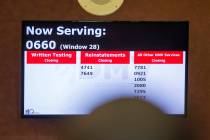EDITORIAL: School budget ‘cuts’
Normally, it would be welcome news when budget numbers change to allow for less spending than originally planned. Any business owner would rejoice at such a development. But the public sector? Not so much.
As reported by the Review-Journal’s Neal Morton, the Clark County School Board on Wednesday approved a preliminary $2.2 billion budget for the 2016-17 school year. That will about $13.9 million less than the district’s spending plan for the current school year.
In addition, the district will fall short of its 323,000 enrollment projection for 2015-16 by about 3,300 students. That means it won’t receive more than $18.4 million in state funding that was included in the current budget.
The budget ramifications for this year will spill over into next, given that enrollment is not expected to grow in 2016-17 either. District officials now forecast that they can expect to bank nearly $2.3 billion in state and local revenue next school year, about $7.6 million less than in 2015-16.
So with fewer students and lower than expected enrollment growth the district gets less money. That might make sense to the taxpayers who fund the district, many of whom haven’t seen their household spending blueprints increase in years. And even with the more frugal budget, the district will still find the money next year to expand all-day kindergarten to all elementary schools, though there will be a tiny uptick in class sizes at elementary, middle school and high school campuses.
“This is the last thing we ever wanted to do,” School Board President Linda Young said about increasing class sizes by a student or two. “It’s not our best approach, (but) we’re required by law to balance our budget.”
Thank goodness for small miracles.
But let’s put these numbers in perspective. The amount the district is “losing” is little more than a rounding error. With $2.3 billion in expected revenue for 2016-17, a $7.6 million reduction in funding amounts to a cut of less than a one-half of 1 percent. The district should be able to absorb this extremely modest difference with minimal distress.























